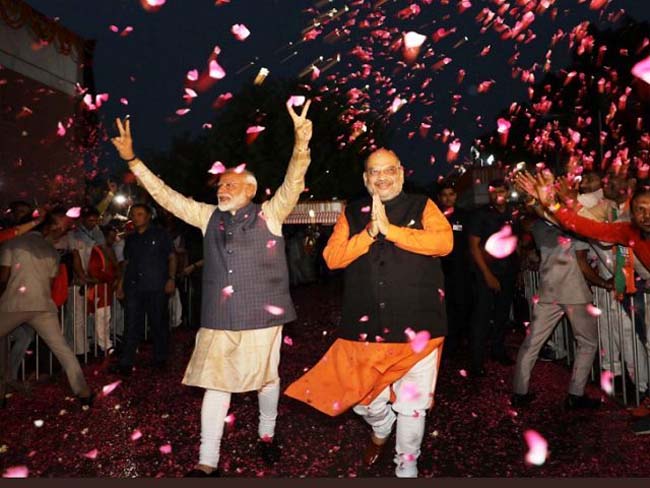 The recent breakage of the three decades old alliance between the BJP and the Shiv Sena has brought in
an important question which the BJP must be concerned about – Will the velocity of the BJP’s growth
make it all alone? Has it grown to a level where its own partners are scared of its further growth?
The recent breakage of the three decades old alliance between the BJP and the Shiv Sena has brought in
an important question which the BJP must be concerned about – Will the velocity of the BJP’s growth
make it all alone? Has it grown to a level where its own partners are scared of its further growth?

Though India has got independence with a bitter partition on religious lines, the politics in the
independent India has been largely driven by the ideologies of secularism and socialism and not by the
idea of majoritarian. With such political environment in the country, when in 1980, the BJP came into
existence as a reincarnation of the Jan Sangha carrying its Hindutva ideology, it was a clear odd man out
in the politics of the country. This distinction worked in favor of the BJP and the party’s base grew up fast
harping the sentiments of the majority Hindus, who had the feeling that there was a consistent
appeasement to the minorities by the governments in the country. At the same time, BJP found it real
difficult to find friends and partners due to its strong rightist ideology.
In the 1984 general election, in its first foray in the national politics, it won 2 seats, and from there it
picked up the speed and went on to win 85 seats in the 1989 general election and then 120 seats in the
1991 general election. In just one decade, it established itself as an indispensable power in the politics of the country, but its influence was mostly limited to the Hindi heartland and that too in the urban areas and
more among the upper castes. In spite of consistent efforts, it was finding it difficult to expand its base
beyond that and that made it realize that it needs strong partners to further grow and get into power.
At that time, there were quite a few parties in different states who were political opponents to the
Congress party or one of its allies, obviously such parties allying with the BJP would had been beneficial
for either of them. But most of these parties had strong reservation with the BJP’s rightist ideology and its
stand on some of the controversial issues. Understanding these facts and its own limitations, the BJP
started adopting soft Hindutva, it brought ahead Atal Bihari Vajpayee – the liberal, highly respected
leader across party lines - in the party and declared him its prime ministerial candidate. It went a step
ahead and offered the prospective partners to work on a common minimum program. Such initiatives
started working out and the BJP was no more untouchable in the politics of the country.
During this process, the BJP not only partnered with smaller parties but allowed them to grow and take
the larger political space and agreed to be the junior partner. In Bihar it partnered with the newly formed
Samata Party (now JD (U)) of Nitish Kumar, in Odisha it partnered with the BJD of Naveen Patnaik who
was trying to get into the legacy of late Biju Patnaik, in Maharashtra it partnered with the Shiv Sena who
was trying to establish itself into the main stream politics.
All these efforts worked for the BJP and it was successful in building the largest ever political alliance in
the history of independent India - the National Democratic Alliance (NDA). It came into power for 13
days in 1996, and 13 months in 1998 and finally in the 1999 national election it got clear mandate and it
served a full 5 year term in the government. The credit went to Atal Bihari Vajpayee’s inclusive policies
and the large set of NDA partners who not only brought numbers on the table but also helped the BJP
improve its tally.
But in spite of an overall good performance by the Vajpayee government, the NDA lost the mandate in
the 2004 general election. Further in the 2009 general election, in spite of serious corruption chargesagainst the Manmohan Singh government, the UPA won the election once again. It was clear that the
UPA had won less because of its strength and more because of the NDA’s weakness. Obviously, the BJP
and the NDA were struck at some point and were not able to go beyond that and present themselves as a
better alternative to the electorate. At this point, the BJP decided to try out a different strategy - instead of
depending so much on its partners, lead the battle aggressively from the front everywhere in the country.
For the 2014 general election, it brought ahead Narendra Modi, the then CM of Gujrat and the poster boy
of Hindutva and declared him its prime ministerial candidate in spite of disagreement with some of its
long time partners. Protesting this decision, the JD (U) walked out of the NDA, but the BJP stayed firm
on its new strategy and didn’t bother much. It pitched in Narendra Modi as an aggressive alternative with
the agenda of development, governance, Hindutva and Nationalism. The new strategy worked well - the
NDA got huge mandate and the BJP got majority of its own, this was the first instance when a non-
Congress party got majority of its own in a general election. This brought high level of enthusiasm and
confidence among the leaders and the cadre of the BJP, this got further strengthened with the BJP
convincingly winning one after another state elections.
In the 2019 general election, Narendra Modi had eventually become the central issue. The NDA had
asked votes in his name and the opposition had asked votes against him. Even the NDA partners who
were uncomfortable with the growing stature of Narendra Modi were seen asking votes in his name. It
was a grand elevation for Narendra Modi and the BJP in the politics of the country, but it was also a big
gamble as well, and he came out of it as winner establishing himself and the BJP at the top of politics in
the NDA and in the country.
In last 5 years, politics has changed a lot in the country and it has changed equations in the ruling alliance
- the NDA as well. Still, the BJP and its partners in the states need each other, but now it is the BJP which
is stronger in most of the states, and is helping its partners win elections and not the other way as was the
case in the past. When the BJP gave only token representation to the partners in the new Modi
government, it implicitly conveyed this fact to its partners. Obviously the partners who had been getting
lot of importance in the NDA got upset and wary of their lessening clout in the NDA - be it the Shiv Sena
or the JD (U) or any other party.
The recent crisis in the NDA in Maharashtra has to be looked at from this angle, the Shiv Sena must be
having an idea that its alliance with the Congress and the NCP will not last long, but its immediate need
was to come out of the growing shadow of the BJP and get rid of the BJP’s B team tag in the state. The
AJSU exit from the NDA in Jharkhand can also be looked at from a similar angle. It would not be a surprise, if going forward similar situation arises in some other states as well. Apart from that, the BJP
needs to take a call on how it wants to grow in states like Odisha, Telangana and Andhra Pradesh where it
has strong potential partners for future. With its past experience, it knows that it needs partners, but at the
same time it has to grow itself to create the momentum and to be in power. The simple formula of physics – momentum = size (mass) * velocity - applies here, the BJP will have to find what should be the right
value of the velocity of its growth and the size of the NDA. At some places it will have to go with its own
strength and go for its own growth but at some places it may have to deaccelerate its own speed in order
to keep the partners intact. Ironically, the BJP is at an important junction in its political journey, where it
must act judiciously as whatever decisions it takes here will have long lasting impact not only on the BJP
but on the NDA and the overall politics of the country as well.
* Rahul Vatsa is an IT professional from Bihar. He can be reached at vatsa.rahul@gmail.com
